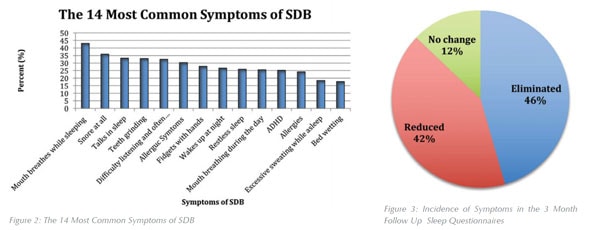 Sleep Disordered Breathing in children is a much more critical and common problem than what has been previously thought. SDB can manifest itself in a variety of outward symptoms that can be easily over-looked, misdiagnosed, and, most unfortunately, left untreated. The Healthy Start system is a non-invasive, non-pharmaceutical, natural form of treatment that uses a series of specially designed appliances to promote proper breathing habits. The Healthy Start addresses mouth breathing, snoring, open-bite, cross bite, narrow palate, improper jaw development, speech difficulties, thumb/finger sucking, and improper swallowing. The system treats orthodontic problems such as crowding, overbite, overjet, gummy smiles, and class III corrections.
Sleep Disordered Breathing in children is a much more critical and common problem than what has been previously thought. SDB can manifest itself in a variety of outward symptoms that can be easily over-looked, misdiagnosed, and, most unfortunately, left untreated. The Healthy Start system is a non-invasive, non-pharmaceutical, natural form of treatment that uses a series of specially designed appliances to promote proper breathing habits. The Healthy Start addresses mouth breathing, snoring, open-bite, cross bite, narrow palate, improper jaw development, speech difficulties, thumb/finger sucking, and improper swallowing. The system treats orthodontic problems such as crowding, overbite, overjet, gummy smiles, and class III corrections.
 Early intervention is critical when addressing sleep issues. The optimal age for a Healthy Start patient is between 2 to 12 years of age. The first step is to have a parent complete the Healthy Start Sleep Questionnaire (Figure 1), a series of 27 observable symptoms. With each symptom identified, the parent assigns a severity score from 1 to 5.
Early intervention is critical when addressing sleep issues. The optimal age for a Healthy Start patient is between 2 to 12 years of age. The first step is to have a parent complete the Healthy Start Sleep Questionnaire (Figure 1), a series of 27 observable symptoms. With each symptom identified, the parent assigns a severity score from 1 to 5.
A recent study of 501 Healthy Start patients from the ages of 2 to 19 found that 9 out of 10 children display at least one symptom of Sleep Disordered Breathing.1 This study also found that between 4 and 12 years of age, 92.6% of symptoms did not self correct while 30% worsened with age. The four most common symptoms found amongst this sample include mouth breathing, snoring, talking in sleep, and teeth grinding. The dentist is well positioned to uncover these problems and guide the parents into seeking a solution.
 The Healthy Start system consists of a series of oral appliances that are worn initially at nighttime and then includes progression of appliances to be worn up to two hours per day. The initial Healthy Start appliance begins to address these habits. The Habit Corrector appliance is worn every night to help the patient accommodate to keeping the appliance in the mouth all night long. Mouth breathers wear the appliance while sleeping and with consistent nighttime wear, the mouth breathing is eliminated and converted into nasal breathing which promotes healthy habits and maxillary development.
The Healthy Start system consists of a series of oral appliances that are worn initially at nighttime and then includes progression of appliances to be worn up to two hours per day. The initial Healthy Start appliance begins to address these habits. The Habit Corrector appliance is worn every night to help the patient accommodate to keeping the appliance in the mouth all night long. Mouth breathers wear the appliance while sleeping and with consistent nighttime wear, the mouth breathing is eliminated and converted into nasal breathing which promotes healthy habits and maxillary development.
A follow-up sleep questionnaire is filled out after the first three months of treatment. The same parent who initially filled out the questionnaire fills out the follow-up. Figure 3 shows the results of 61 randomly selected follow-up questionnaires providing evidence that out of the total number of symptoms analyzed 88% were corrected: 46% completely eliminated, and 42% reduced.
To correct or modify these sleep symptoms, particularly before a child enters school, can be a life saving procedure and one that can greatly improve the child’s well-being in school and their normal social interaction with other children. To alter even a single symptom, such as prolonged bed-wetting, can dramatically change a child’s life. It is essential that treatment to alleviate SDB symptoms in children begin as early as possible to set the growing dental/skeletal patterns right. Correction and promotion of proper oral habits puts the child on a path to a long and healthy life.
Professionals interested in gaining a greater understanding of SDB and how the Healthy Start System addresses both sleep and skeletal growth conditions can participate in a two-day course. This course provides the necessary information for both the Doctor and staff to identify, evaluate and understand the treatment protocols. Learning is enhanced with a hands-on experience with patients and parents. Please visit www.TheHealthyStart.com for upcoming dates and more information.
Stay Relevant With Dental Sleep Practice
Join our email list for CE courses and webinars, articles and more..

